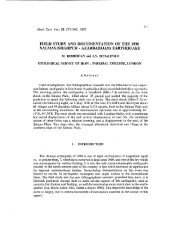PDF COPY - Manuel berberian
PDF COPY - Manuel berberian
PDF COPY - Manuel berberian
You also want an ePaper? Increase the reach of your titles
YUMPU automatically turns print PDFs into web optimized ePapers that Google loves.
Geirud Formation in the Alborz mountains (Assereto<br />
1963; Sieber 1970), in the Khoshyeilagh Formation of<br />
the Jajarm area, northeast Iran (Bozorgnia 1973), in the<br />
Talesh mountains (Davies et al. 1972; Clark et al.<br />
1975), and in the Anarak region in Central Iran (Reyre<br />
and Mohafez 1972). Post-Silurian pre-Carboniferous<br />
basic volcanics under a cover of Permo-Carboniferous<br />
limestone, together with a Lower Carboniferous andesite,<br />
are reported from the Talesh mountains, southwest<br />
of the Caspian Sea (Clark et al. 1975; Table 1). The<br />
Devonian-Carboniferous basalts along the Sanandaj-<br />
Sirjan belt (Berberian and Nogol 1974; Berthier et al.<br />
1974; Berberian 1977a; Alric and Virlogeux 1977) suggest<br />
rifting during this phase. Subsequent closure of the<br />
rift seems to be responsible for the late Paleozoic (Hercynian)<br />
low-grade metamorphism along the belt (see<br />
Section II.2.2b; and Fig. 11).<br />
lI.2a.l.3--Permian-Triassic extensional phase--This<br />
is an important rifting phase which apparently marks the<br />
onset of the opening of the High-Zagros Alpine and the<br />
narrow Central Iranian ocean belts (see Section 11.2.2,<br />
and Figs. 4 and 11). No previous extensional phase left<br />
any evidence of having produced oceanic crust. This<br />
phase is mainly developed along the Sanandaj-Sirjan<br />
belt with basic (basalt, diabase, and some intermediate)<br />
volcanic activity (Thiele et al. 1968; Dimitrijevic 1973;<br />
Berberian and Nogol 1974; Berthier et al. 1974; Berberian<br />
1977a; Alric and Virlogeux 1977; Table 1). Some<br />
Permian andesitic volcanics are reported from the Talesh<br />
mountains of the southwest Caspian Sea (Davies et<br />
al. 1972; Clark et al. 1975). Lower Permian basic volcanics<br />
also occurred in the Dorud and Ruteh Formations<br />
of the Qazvin area (Annells et al. 1975). There is only<br />
one example of basaltic flow of Permian age reported<br />
from the High-Zagros belt, west of Dehbid (Hushmandzadeh<br />
1977).<br />
H.2a.2--Paleozoic paleomagnetic data<br />
The geological observations indicating a coherent<br />
Iranian-Gondwanaland continental landmass during the<br />
late Precambrian to Permian time interval are consistent<br />
with the paleomagnetic results. Paleomagnetic evidence<br />
from the Upper Precambrian rocks and iron ores of the<br />
Central Iranian Bafq area (Becket et al. 1973), from the<br />
Lower Paleozoic rocks of Kuh-e-Gahkom and Surmeh<br />
of the Zagros belt (Burek and Furst 1975), from the<br />
Cambrian Purple Sandstone of the Salt Range of Pakistan<br />
(McElhinny 1970), from the upper Devonian<br />
lower Carboniferous Geirud Formation of the Alborz<br />
mountain in north Iran (Wensink et al. 1978), and from<br />
the Upper Precambrian, Ordovician, and Permian rocks<br />
of Central Iran (Soffel et al. 1975; Sorrel and Forster<br />
1977) show similar virtual geomagnetic poles with those<br />
of Afro-Arabia. This and the widespread similarity of<br />
Paleozoic sedimentation (Table 1) indicate that during<br />
BERBERIAN AND KING 231<br />
the late Precambrian and Paleozoic, Central Iran, the<br />
Alborz in northern Iran, the Salt Ranges of Pakistan in<br />
the east, the Zagros in south Iran, and much of southeastern<br />
Turkey, were parts of Gondwanaland (Fig. 3).<br />
However, they do not eliminate the possibility of large<br />
latitudinal differences.<br />
H.2b--Asiatic northern Iran (Kopeh Dagh belt) during<br />
the Paleozoic Era<br />
There is a major difference between the Paleozoic -<br />
early Mesozoic history of Iran in the south and that of the<br />
Kopeh Dagh and Great Caucasus - Transcaucasian median<br />
mass in the north. In contrast to the Iranian Paleozoic<br />
stable platform-type shelf sedimentation (absence<br />
of granitic intrusion or widespread volcanic activity and<br />
unconformities), an eugeosynclinal regime with widespread<br />
subsidence, uplift, granitization, volcanism, regional<br />
metamorphism, and folding existed in the Caucasus<br />
and Kopeh Dagh during Paleozoic time (Keller<br />
and Predtechensky 1968; Nalvkin and Posner 1968;<br />
Adamia 1968, 1975; Belov 1972; Khain 1975; Adamia<br />
et al. 1977). The geosynclinal regime in the Great<br />
Caucasus began in early Cambrian time. This Paleozoic<br />
geosynclinal basin encompassed the areas of the Front<br />
Range, the Main Range, and the South Slope of the<br />
Great Caucasus. In the north, it was bordered by the<br />
Cherkassy-Kislovodsk uplift and in the south by the<br />
Transcaucasian median mass (Belov 1972). Adamia et<br />
al. (1977) assumed that the axial part of the Tethys<br />
Paleozoic and Mesozoic times ran across the Sevan-<br />
Akera ophiolite belt of the Little Caucasus, northwest of<br />
Iran (Fig. 1).<br />
ll.2.1--Early Paleozoic (Caledonian) movements (450-<br />
390 Ma)<br />
During the Ordovician - early Devonian time interval,<br />
the Caledonian orogeny affected the North Atlantic<br />
region. The Caledonian fold belt in northwestern Europe<br />
originated with the closure of the Caledonian (Iapatus)<br />
Ocean. The Iapatus Ocean, which separated Laurentia<br />
(North America) and Baltica (northern Europe), closed<br />
along the Acadian-Caledonian eugeosynclinal belt of<br />
northern Europe and eastern North America (Dewey<br />
1969; Bird and Dewey 1970; Ziegler et al. 1979). North<br />
America, Greenland, and the Russian platform were united<br />
into a single continental mass, Laurasia. Farther<br />
east, Hamilton (1970) suggested that the Russian plate<br />
and an island arc collided in early Devonian time.<br />
Iran being far from this collision zone suffered only<br />
epeirogenic movements characterized by regional<br />
regression of the Silurian sea (Table 1) and regional<br />
disconformity and some local unconformities (in the<br />
north) at the base of the Middle-Upper Devonian rocks<br />
(Stocklin 1968a; Nabavi 1975, 1976; Berberian 1976a).<br />
The large Silurian--Carboniferous sedimentary gap in<br />
the Zagros (following the Ordovician and (or) lower







